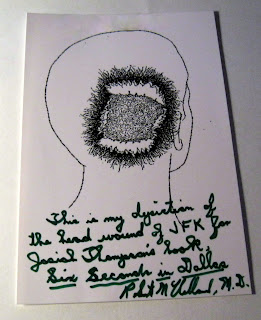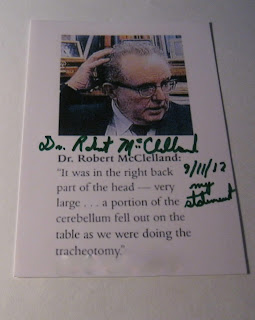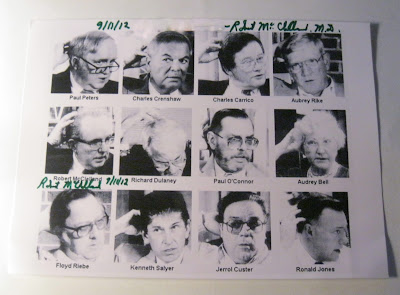Dr. McClelland's story is almost unbelievable: Not only was he on hand
to assist the surgical team trying to save President Kennedy's life
after the motorcade shooting in 1963, he was also called in two days
later to tend to Lee Harvey Oswald's (fatal) wounds.
(His accounts of these two emergency room proceedings are both coldly
clinical and harrowing. In the case of the late president, for instance,
McClelland describes how a portion of Kennedy's cerebrum fell out of
the gaping wound in his skull and onto the operating table while
surgeons were exploring a wound in his throat.)
Two years prior to the presidential assassination, McClelland paid a
visit to Baylor Hospital to pick up his wife's paycheck. As he
approached the side door, three black limos pulled up. A stern looking
character invited the doc to step aside -- which he did -- and out of
one of the cars stepped President John F. Kennedy. The new president was
there to visit Senator Sam Rayburn, hospitalized for pancreatic cancer.
On a later occasion, McClelland was called in to assist a colleague with
an exploratory surgery. Arriving at the hospital, he was directed to
the operating room and took time to check the patient's clipboard
beforehand. His name? Abraham Zapruder.
Interestingly, Dr. McClelland is convinced that more than one shooter
was involved in the Kennedy assassination. According to Marian Ann J.
Montgomery -- now Executive Director of PCHPS and one-time director of
interpretation at the Sixth Floor Museum -- he is one of the few doctors
on the scene at the time who now support this view.
PHOTO signed for me: Dr. Robert McClelland holds the blood-stained shirt he wore in the
Parkland Hospital Emergency Room on the day he and other doctors tried
to save John Kennedy Randal Ford
Testimony Of Dr. Robert M. Mcclelland Resumed

The testimony of Dr. Robert M. McClelland was taken at 3:25 p.m.,
March 25, 1964, at Parkland Memorial Hospital, Dallas, Tex., by Mr.
Arlen Specter, assistant counsel of the President's Commission.
Mr. SPECTER - May the record show that Dr. Robert M. McClelland
has return to have a brief additional deposition concerning a
translation of "L' Express which has been called to my attention in the
intervening time which has elapsed between March 21, when I took Dr.
McClelland's deposition on the first occasion, and today.
Dr. McClelland, will you raise your right hand? Do you solemnly swear
that the testimony you will give to the President's Commission in this
deposition proceeding will be the truth, the whole truth and nothing but
the truth, so help you God?
Dr. McCLELLAND - I do.
Mr. SPECTER - Dr. McClelland, I show you a translation from the
French, of the magazine, "L' Express" issue of February 20, 1964, and
ask you if you would read this item, with particular emphasis on a
reference to a quotation or statement made by you to a reporter from the
St, Louis Post Dispatch.
Dr. McCLELLAND - (Examined instrument referred to.)
Mr. SPECTER - Now, have you had an opportunity to read over that excerpt?
Dr. McCLELLAND - Yes.
Mr. SPECTER - Did you talk to a reporter from the St. Louis Post Dispatch about this matter?
Dr. McCLELLAND - Yes.
Mr. SPECTER - And what was his name?
Dr. McCLELLAND - Richard Dudman.
Mr. SPECTER - And when did you have that conversation with Mr. Dudman
Dr. McCLELLAND - As well as I recall, it was the day after the
assassination, as nearly as I can recall, but I'm not certain about
that.
Mr. SPECTER - Will you tell me as closely as you remember what he said to you and you said to him, please?
Dr. McCLELLAND - The main point he seemed to be making was to
attempt to define something about the wound, the nature of the wound,
and as near as I can recall, I indicated to him that the wound was a
small undamaged--- appearing punctate area in the skin of the neck, the
anterior part of the neck, which had the appearance of the usual
entrance wound of a bullet, but that this certainly could not be----you
couldn't make a statement to that effect with any complete degree of
certainty, though we were, as I told him, experienced in seeing wounds
of this nature, and usually felt that we could tell the difference
between an entrance and an exit wound, and this was, I think, in essence
what I told him about the nature of the wound.

Mr. SPECTER - Now, had you actually observed the wound prior to the time the tracheotomy was performed on that neck wound?
Dr. McCLELLAND - No; my knowledge of the entrance wound, as I
stated, in my former deposition, was merely from what Dr. Perry told me
when I entered the room and began putting on a pair of surgical gloves
to assist with the tracheotomy.
Dr. Perry looked up briefly and said that they had made an incision and
were in the process of making an incision in the neck, which extended
through the middle of the wound in question in the front of the neck.
Mr. SPECTER - Now, you have just characterized it in that last answer as an entrance wound.
Dr. McCLELLAND - Well, perhaps I shouldn't say the wound anyway, not the entrance wound--that might be a slip of the tongue.
Mr. SPECTER - Do you have a firm opinion at this time as to whether it is an entrance wound or exit wound or whatever?
Dr. McCLELLAND - Of course, my opinion now would be colored by
everything that I've heard about it and seen since, but I'll say this,
if I were simply looking at the wound again and had seen the wound in
its unchanged state, and which I did not, and, of course, as I say, it
had already been opened up by the tracheotomy incision when I saw the
wound--but if I saw the wound in its state in which Dr. Perry described
it to me, I would probably initially think this were an entrance wound,
knowing nothing about the circumstances as I did at the time, but I
really couldn't say--that's the whole point. This would merely be a
calculated guess, and that's all, not knowing anything more than just
seeing the wound itself.
Mr. SPECTER - But did you, in fact, see the wound prior to the time the incision was made?
Dr. McCLELLAND - No.
Mr. SPECTER - So that any preliminary thought you had even, would be based upon what you had been told by Dr. Perry?
Dr. McCLELLAND - That's right.
Mr. SPECTER - Now, did you tell Mr. Dudman of the St. Louis Post
Dispatch that you did not in fact see the wound in the neck, but your
only information of it came from what Dr. Perry had told you?
Dr. McCLELLAND - I don't recall whether I told him that or not. I
really don't remember whether I said I had seen the wound myself or
whether I was merely referring to our sort of collective opinion of it,
or whether I told him I had not seen the wound and was merely going by
Dr. Perry's report of it to me. I don't recall now, this far away in
time exactly what I said to him.
Mr. SPECTER - Dr. McClelland, I want to ask you a few additional
questions, and some of these questions may duplicate questions which I
asked you last Saturday, and the reason for that is, we have not yet had
a chance to transcribe the deposition of last Saturday, so I do not
have before me the questions I asked you at that time and the answers
you gave, and since last Saturday I have taken the depositions of many,
many doctors on the same topics, so it is not possible for me to be
absolutely certain of the specific questions which I asked you at that
time, but permit me to ask you one or several more questions on the
subject.
First, how ma

ny bullets do you think were involved in inflicting the wounds on President Kennedy which you observed?
Dr. McCLELLAND - At the present time, you mean, or at the immediate moment?
Mr. SPECTER - Well, take the immediate moment and then the present time.
Dr. McCLELLAND - At the moment, of course, it was our impression
before we had any other information from any other source at all, when
we were just confronted with the acute emergency, the brief thoughts
that ran through our minds were that this was one bullet, that perhaps
entered through the front of the neck and then in some peculiar fashion
which we really had, as I mentioned the other day, to strain to explain
to ourselves, had coursed up the front of the vertebra and into the base
of the skull and out the rear of the skull.
This would have been a very circuitous route for the bullet to have
made, so that when .we did find later on what the circumstances were
surrounding the assassination, this was much more readily explainable to
ourselves that the two wounds were made by two separate bullets.
Mr. SPECTER - And what is your view or opinion today as to how many bullets inflicted the injuries of President Kennedy?
Dr. McCLELLAND - Two.
Mr. SPECTER - Now, what would be the reason for your changing your opinion in that respect?
Dr. McCLELLAND - Oh, just simply the later reports that we heard
from all sources, of all the circumstances surrounding the
assassination. Certainly no further first-hand information came to me
and made me change my mind in that regard.
Mr. SPECTER - Dr. McClelland, let me ask you to assume a few
additional facts, and based on a hypothetical situation which I will put
to you and I'll ask you for an opinion.
Assume, if you will, that President Kennedy was shot on the upper right
posterior thorax just above the upper border of the scapula at a point
14 Cm. from the tip of the right acromion process and 14 cm. below a tip
of the right mastoid process, assume further that that wound of entry
was caused by a 6.5-mm. missile shot out of a rifle having a muzzle
velocity of approximately 2,000 feet per second, being located 160 to
250 feet away from President Kennedy, that the bullet entered on the
point that I described on the President's back, passed between two strap
muscles on the posterior aspect of the President's body and moved
through the fascial channel without violating the pleura cavity, and
exited in the midline lower third anterior portion of the President's
neck, would the hole which Dr. Perry described to you on the front side
of the President's neck be consistent with the hole which such a bullet'
might make in such a trajectory through .the President's body?
Dr. McCLELLAND - Yes; I think so.
Mr. SPECTER - And what would your reasoning be for thinking that
that would be a possible hole of exit on those factors as I have
outlined them to you?
Dr. McCLELLAND - Well, I think my reasoning would be basically that
the missile was traveling mainly through soft tissue, rather than
exploding from a bony chamber and that by the time it reached the neck
that it had already lost, because of the distance from which it was
fired, even though the muzzle velocity was as you stated--would have
already lost a good deal of it's initial velocity and kinetic strength
and therefore would have perhaps made, particularly, if it were a
fragment of the bullet as bullets do sometimes fragment, could have made
a small hole like this in exiting. It certainly could have done that.

Mr. SPECTER - What would have happened then to the other portion of the bullet if it had fragmented?
Dr. McCLELLAND - It might have been left along, or portions of it
along the missile track--sometimes will be left scattered up and down
this. Other fragments will maybe scatter in the wound and sometimes
there will be multiple fragments and sometimes maybe only a small
fragment out of the main bullet, sometimes a bullet will split in
half--this is extremely difficult for me to say just what would happen
in a case lake that.
Mr. SPECTER - Well, assuming this situation--that the bullet did not
fragment, because the autopsy report shows no fragmentation, that is,
it cannot show the absence of fragmentation, but we do know that there
were no bullets left in the body at any point, so that no fragment is
left in.
Dr. McCLELLAND - I think even then you could make the statement that
this wound could have resulted from this type bullet fired through this
particular mass of soft tissue, losing that much velocity before it
exited from the body. Where you would expect to see this really great
hole that is left behind would be, for instance, from a very high
velocity missile fired at close range with a heavy caliber bullet, such
as a .45 pistol fired at close range, which would make a small entrance
hole, relatively, and particularly if it entered some portion of the
anatomy such as the head, where there was a sudden change in density
from the brain to the skull cavity, as it entered. As it left the body,
it would still have a great deal of force behind it and would blow up a
large segment of tissue as it exited. But I don't think the bullet of
this nature fired from that distance and going through this large area
of homogenous soft tissue would necessarily make the usual kind of exit
wound like I just described, with a close range high velocity heavy
caliber bullet.
This is why it would be difficult to say with certainty as has been
implied in some newspaper articles that quoted me, that you could tell
for sure that this was an entrance or an exit wound. I think this was
blown up a good deal.
Mr. SPECTER - Dr. McClelland, why wasn't the President's body turned over?
Dr. McCLELLAND - The President's body was not turned over because
the initial things that were done as in all such cases of extreme
emergency are to first establish an airway and second, to stop
hemorrhage and replace blood, so that these were the initial things that
were carried out immediately without taking time to do a very thorough
physical examination, which of course would have required that these
other emergency measures not be done immediately.
Mr. SPECTER - Did you make any examination of the President's back at all?
Dr. McCLELLAND - No.
Mr. SPECTER - Was any examination of the President's back made to your knowledge?
Dr. McCLELLAND - Not here no.
Mr. SPECTER - Do you have anything to add which you think might be helpful in any way to the Commission?
Dr. McCLELLAND - No; I think not except again to emphasize perhaps
that some of our statements to the press about the nature of the wound
may have been misleading, possibly--probably ,because of our fault in
tolling it in such a way that they misinterpreted our certainty of being
able to tell entrance from exit wounds, which as we say, we generally
can make an educated guess about these things but cannot be certain
about them. I think they attributed too much certainty to us about that.
Mr. SPECTER - Now, have you talked to anyone from the Federal
Government about this matter since I took your deposition last Saturday?
Dr. McCLELLAND - No.
Mr. SPECTER - And did you and I chat for a moment or two with my
showing you this translation of "L' Express" prior to the time we went
on the record here?
Dr. McCLELLAND - Yes.
Mr. SPECTER - And is the information which you gave to me in response to my questions the same that we put on the record here?
Dr. McCLELLAND - To the best of my knowledge---yes
Mr. SPECTER - Thank you very much, Dr. McClelland.
Dr. McCLELLAND - All right. Thank you


